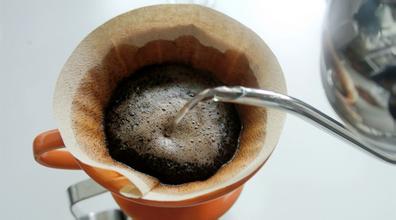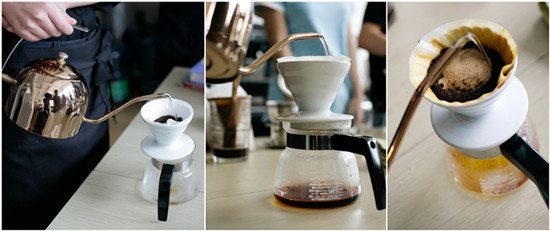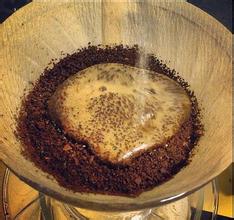Introduction to coffee brewing by hand: introduction to the basics of hand-brewing coffee-water flow

Last time I talked about the posture of hand-brewing coffee, mastering a good posture is certainly conducive to making a good cup of coffee, because only a comfortable and stable posture can ensure a stable flow of water, so what we want to talk about here is the problem of water flow.
The current is too thick!
The current is too fast!
The current is thick and thin!
The current is always shaking!
The current is always cut off!
This is probably a problem often encountered by beginners.
So how to solve these problems?-practice! Only practice! So how to practice? Here I have sorted out a hand-brewed coffee flow practice trilogy according to the progress of the students' practice and frequently asked questions, combined with my own experience in the original practice.
Step 1: at the beginning of the exercise, the flow should be very fine, very slow, and extremely uniform. Just like practicing martial arts, you have to cheat, squat and squat absolutely firmly, so you should keep the current to the highest standard when practicing, so that you can have a solid foundation so that you can collect and release it freely when making coffee. Well, there is also a limit to the fineness here, that is, at the beginning of water injection, slowly tilt the spout to let the water flow out as a drop, and then continue to tilt to change the flow from a drop to a slightly curved flow, and then continue to tilt a little bit, so that the water is thicker and flows out vertically in a straight line. this is the flow standard required in the initial practice. How slow is it? When watering the kettle, the water flow is used to draw the concentric circle, so the speed of the circle should be as low as possible, as long as the hand flushing pot is rotating. Extremely uniform, including the thickness and speed of the water should be uniform and stable, not fast and slow, thick and thin. According to this standard, if you practice continuously for more than an hour every day, you may get sore hands and arms because you can't adapt to it in the first two days, but remember to stick to it here! Hold on for more than an hour to get used to it! If you stick to it, you can basically stabilize the current in three days, and you can usually feel obvious progress in a week or so: the water can be controlled more finely and evenly, and your hands will not be so sore and uncomfortable.
Step 2: soften the current.
The water flow is basically stable, but at this time, although the water is slender and uniform, it appears to be relatively tense and stiff, so the current is relatively strong, which is easy to wash away the coffee powder and flush out the astringent and mixed taste. Just like after a torrential rain in summer, the ground will be covered with ditches washed out by Rain Water, but after a fine spring rain, the ground absorbs enough water and becomes denser and smoother. The water flow practice at this time should also look for such a feeling, when the water is poured down, feel that the water is gently pounced on the coffee powder instead of pouring it, allowing the water to pass gently through the coffee powder and extract the good flavor ingredients.
Step 3: adjust the current as you like.
Practicing the flow of water is like practicing martial arts. When you can control the flow and keep the soft flow, it shows that you already have some "internal skills". If you want to practice each move according to the formula at the beginning, then you should learn to be flexible after you have mastered all kinds of moves. In other words, for different coffee beans, different grinding degrees, different filters, different freshness, you can properly adjust the thickness, height and speed of the flow. Of course, the adjustment should also have a certain degree, in principle, how to ensure that the flow of water is soft to avoid extraction, and at the same time, there should be a certain degree of strength to ensure that it can be fully extracted. If the first two steps are mainly achieved through a certain amount of practice, then this step not only requires a long time of practice, but also requires the understanding of coffee beans and personal feelings, of course, this feeling also comes from a lot of theoretical accumulation and experience.
This water flow trilogy, in fact, is through the process of approaching the hand-brewing coffee to walking into the coffee, until every cup of coffee can be extracted like a master playing with a sword to extract the "true taste" of coffee, that is, the highest level of water flow kung fu.
Source:
The blog of the world of coffee with two bottles of water
Important Notice :
前街咖啡 FrontStreet Coffee has moved to new addredd:
FrontStreet Coffee Address: 315,Donghua East Road,GuangZhou
Tel:020 38364473
- Prev

Introduction to coffee brewing by hand: introduction to hand-brewing coffee making-posture
Among the many methods of making coffee, hand brewing can not only give full play to the rich and fresh aroma of coffee in taste, maintain the pure taste and rich and soft taste of coffee, and maximize the personality of coffee, but also has the advantages of easy operation, easy to learn and easy to make. The appliance is easy to manage and so on. But this does not mean that making coffee by hand means brewing coffee at will without any basis.
- Next

Coffee brewing by hand: analysis and treatment of the "channel effect" of hand-brewed coffee
Previously, we only know that the channel effect often encountered in espresso extraction is that in the process of extraction, the flow caused by the uneven degree of grinding, powder distribution, packing and the outlet of the machine head water distribution network passes through the weakest part of the coffee pressed powder, resulting in uneven espresso extraction, excessive extraction of the part passed by the water flow, insufficient extraction of the rest, and often get a strong cup in the end.
Related
- What is the meaning of lactic acid fermentation with coffee bean treatment?
- How to judge the state of foam by sound?
- How does the latte pull out the unicorn pattern? Come to get for a little trick to improve the flower pull!
- Will flower pulling affect the taste of the latte?
- Do you know the history of coffee?
- The difference between honey treatment and sun washing what is raisin honey treatment?
- What kind of milk can a novice use to make coffee foam to keep the foam longer? The correct method and skills of milking tutorial sharing
- Why do washed coffee beans taste sour? Flavor characteristics of washed Coffee
- Introduction to the skill of how to practice the size and height of water injection around the circle of hand-brewed coffee
- How do beginners practice coffee flower drawing from scratch?

